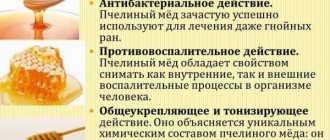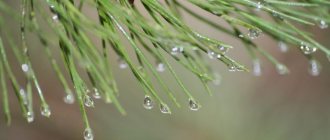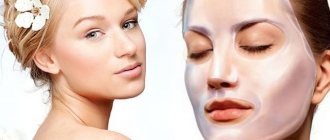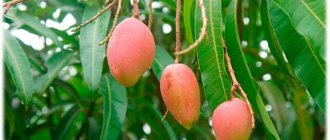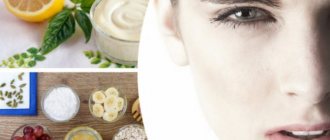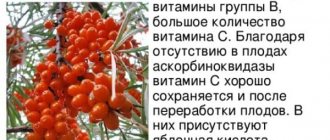The exotic fruit mango is a common ingredient in recipes, professional and medicinal cosmetics. Its unique chemical composition is favorably perceived by epidermal cells. And the skin becomes younger and more elastic. And together with other properly selected components, a mango mask can solve various skin problems. There are no risks when using the fruit.
In this article we will reveal the secrets of preparing masks that will effectively transform your facial skin and make it glow with health, gaining a second youth.
Botanical characteristics
Today there are over 2,000 different varieties of mangoes. They are conventionally divided into 2 types: Indo-Chinese (greenish and elongated fruit), Indian (orange-yellow and round). In addition, intervarietal hybrids are known - Indo-Chinese.
The most popular crops suitable for growing in a small garden or in a container on the balcony include the following crops:
- Cogshall;
- "Carrie"
- "Fairchild"
- "Ice Cream";
- "Julie"
- Lancettila;
- "Brooks";
- Mallika;
- "Okrung"
- "Neelum"
The weight of a ripe mango fruit is 200 - 300 grams, and the diameter depends on the plant variety and varies from 10 to 20 centimeters. The fruit tastes vaguely like a peach. The color of the skin depends on the variety and can be yellow-green, deep orange, pink, red, purple.
Mango is an evergreen tree of the tropics that reaches 20 meters in height. This is one of the most durable fruit species. The number of flowers in inflorescences reaches up to 4000 pieces. However, their binding rate is extremely low. A maximum of 2 fruits ripen in one inflorescence.
If the fruit is excessively sour, it is spoiled; if it is tasteless, it is unripe. Ripe fresh mango is sweet, fleshy and juicy, smooth to the touch, elastic with a shiny surface. The presence of dents, defects, or damage indicates that the product has begun to deteriorate.
Small black spots, on the contrary, indicate the ripeness of the fruit.
Wrinkled skin is a sign of stale fruit. If the surface of the mango is wet, then the juice is seeping out. This indicates that the fruit is damaged internally.
When pressed, the peel of a ripe mango springs back and crushes under your fingers. After light pressure, it should restore its original shape. The smell of fresh ripe fruits is sweetish, resinous, coniferous, and is strongly manifested at the stalk. If the mango does not smell, it means it is not yet ripe; it exudes an intense aroma - it is overripe.
The shape of the mango depends on the type of tree and can be elongated-ovoid, spherical, pear-shaped, ovoid. In the center of the fruit there is an inedible, large and heavy seed, 10 centimeters long and weighing 50 grams. The outside of the bone is covered with a protective shell.
Different products for different eye diseases
Depending on the problem you are facing, it is recommended to consume different foods first.
- If your work involves a lot of stress and your eyes get tired quickly, then parsley and carrot juice will help.
- The vessels will remain elastic and strong if you enrich your diet with apricots, both fresh and in the form of dried fruits or juice; rose hips will also help.
- For myopia, hawthorn and pumpkin are good remedies.
- For the development of cataracts, glaucoma, and optic nerve disease, parsley juice is very useful; one tablespoon per day is enough.
Why aren't blueberries on the list? In addition to the fact that it has a general supportive effect rather than a specific one, this summer berry, like carrots, has recently begun to give way to the benefits of green and yellow foods. This is explained by the fact that the latter contain more lutein and zeaxanthin - pigments that have a positive effect on eye health.
Chemical composition
Mango is the most important fruit of the tropics, which in India is called the “fruit of the gods.” Its chemical composition depends on the crop variety and stage of ripening. Green fruits contain a lot of starch, which as the fruit grows turns into simple carbohydrates: maltose, glucose, sucrose.
Unripe mango is a storehouse of pectin.
With the formation of a hard bone, its quantity decreases by more than 2 times. 15 milligrams of green fruit pulp contains the same amount of ascorbic acid as is concentrated in 30 milligrams of lime. At the same time, the presence of malic, succinic, citric, and oxalic organic acids gives the fruit a characteristic, very sour taste. Ripe fruit, on the contrary, is sweet and pleasant to the taste. It contains a lot of sugars, vitamins (A, , C, E, K, PP) and few acids. Table No. 1 “Nutritional value of mango”
| Components | Contents per 100 grams of product |
| Calorie content | 65 calories |
| Water | 83.46 grams |
| Carbohydrates | 15.2 grams |
| Mono- and disaccharides | 13.66 grams |
| Sucrose | 6.97 grams |
| Fructose | 4.68 grams |
| Glucose | 2.01 grams |
| Alimentary fiber | 1.6 grams |
| Squirrels | 0.5 grams |
| Essential amino acids (glycine, glutamic, aspartic acid, alanine, tyrosine, serine, proline) | 0.36 grams |
| Ash | 0.36 grams |
| Essential amino acids (isoleucine, leucine, lysine, arginine, valine, histidine, phenylalanine, methionine, threonine, tryptophan) | 0.316 grams |
| Fats | 0.25 grams |
| Saturated fatty acids (stearic, lauric, myristic, palmitic) | 0.182 grams |
| Omega-9 | 0.075 grams |
| Omega-3 | 0.051 grams |
| Omega-6 | 0.019 grams |
Table No. 2 “Chemical composition of mango”
| Name | Nutrient content per 100 grams of product, milligrams |
| Vitamins | |
| Ascorbic acid (C) | 36,4 |
| Pantothenic acid (B5) | 0,197 |
| Tocopherol (E) | 0,9 |
| Riboflavin (B2) | 0,038 |
| Niacin (B3) | 0,669 |
| Thiamine (B1) | 0,028 |
| Beta-carotene (A) | 0,054 |
| Choline (B4) | 7,6 |
| Pyridoxine (B6) | 0,119 |
| Phylloquinone (K) | 0,0042 |
| Folic acid (B9) | 0,043 |
| Macronutrients | |
| Potassium | 165 |
| Phosphorus | 14 |
| Calcium | 11 |
| Magnesium | 10 |
| Sodium | 1 |
| Microelements | |
| Iron | 0,16 |
| Copper | 0,111 |
| Zinc | 0,09 |
| Manganese | 0,063 |
| Selenium | 0,0006 |
A plant tranquilizer was found in the leaves of the mango tree, and tannins were found in the pulp and skin of the fruit.
Mango face mask. Benefit for health
- Mangoes may have anti-cancer effects due to their high levels of antioxidants that scavenge free radicals. However, scientific data to confirm this is still lacking. Therefore, it is too early to make official statements regarding this property.
- Due to its high content of vitamin A, which is converted into beta-carotene, this fruit is recommended for improving eye health and preventing problems such as.
- It is ideal for maintaining cardiovascular health as it contains fiber and antioxidants. These substances reduce the level of “bad” cholesterol and prevent circulatory problems, as well as clogged arteries and the development of hypertension.
- Insoluble fiber, in addition to its high antioxidant content, makes mango a digestive aid. Add it to your diet to help the body remove waste from the intestines. It reduces inflammation and prevents constipation.
- This fruit is ideal for women who want to get pregnant, as it contains folic acid, which is essential for conception.
- To be strong, you need to consume more foods rich in carotenoids and other important antioxidants. Mangoes contain significant amounts of this type of nutrient and therefore enhance the body's immune response to pathogens.
- It contains trace minerals such as zinc, potassium, selenium and copper, essential for good health.
Beneficial features
The exotic fruit has long been used in Asian medicine to treat cholera and plague. Today, the fruits of the mango tree are used as a hemostatic, diuretic, and antioxidant agent. In addition, they are used to eliminate heartburn and treat acute dermatitis.
In order to cleanse the body of toxins and lose weight, mangoes are consumed with milk. A successful combination of proteins and sugars gives a feeling of satiety, lightness and creates an optimal balance of these compounds in the body.
Ripe, aromatic, sweet fruits with a slight sourness are eaten. When purchasing green fruit, leave it in a dark, warm place to allow it to mature. If a mango is placed in the refrigerator, the fruit will soften and lose its taste and beneficial properties.
The effect of Asian apple on the human body:
- improves vision;
- normalizes digestion, fights heartburn;
- strengthens the immune system;
- protects against sunstroke;
- supports brain function;
- relieves pain;
- restores strength;
- reduces fever;
- relieves inflammation, is used to treat gum diseases (periodontal disease, stomatitis);
- improves mood;
- normalizes sleep;
- increases stress resistance, relieves tension;
- strengthens blood vessels, heart;
- normalizes metabolism;
- prevents the growth of malignant neoplasms of the colon, stomach, mammary, prostate, and pancreas;
- improves bile flow;
- relieves fatigue;
- increases sexual activity;
- thins mucus;
- reduces the manifestations of varicose veins;
- cleanses the intestinal walls of harmful substances.
Mangoes are of particular value to women during pregnancy and lactation. The exotic fruit softens the symptoms of toxicosis, maintains normal hemoglobin levels, and relieves heartburn and constipation.
Mango fruits help restore the female body after childbirth.
During breastfeeding, the fruit is consumed with caution, observing the baby's reaction to the product. If the baby refuses to take milk, is capricious, or redness appears on his body, exclude mangoes from the diet of the young mother. From 8 months, introduce the fruit into your child’s menu in the form of puree or freshly squeezed juice.
To avoid bloating, the fruit is given in small doses (5 grams) at first, then the amount is gradually increased.
To relieve heart pain, hold a piece of mango on the tip of the tongue for 6–7 minutes, and to strengthen the walls of blood vessels, drink a decoction of dried leaves. Traditional healers in India use the seeds of the fruit to treat asthma, the juice of the fruit treats acute dermatitis, and with a mixture of Asian apple pulp, honey and pepper, they remove toxins from the liver and improve the flow of bile.
Unripe mango fruits dried in the sun contain up to 50 milligrams of vitamin C (per 100 grams) and are an indispensable remedy for the prevention of winter hypovitaminosis.
A little history
India is considered the birthplace of mangoes. The popularity of the tasty and healthy fruit of the mango tree has spread the evergreen plant throughout the tropics. Now the crop is actively grown in many countries in Asia, America, and Africa.
Since ancient times in India, mangoes have been used to stop bleeding, improve the functioning of the heart and blood vessels, and activate the functioning of the brain. It has been noted that regular consumption of fruit pulp for food helps stabilize the immune system and protect against respiratory infections.
Oil from the seeds of the plant quickly gained popularity in cosmetology. The oily butter perfectly replaced the cream, saving the skin from the sun, wind, and their negative effects. The substance helped eliminate dryness, flaking, and cracks.
Anti-cancer properties
According to research by scientists from the University of Texas, mangoes are an effective remedy for preventing breast cancer. The power of tropical fruit is in polyphenols. Antioxidants from plant foods exhibit anti-inflammatory properties and help reduce oxidative stress, which leads to the development of chronic diseases and the growth of malignant tumors. In addition, mangoes contain flavonoids, carotenoids, and phenolic compounds that suppress harmful bacterial environments.
Polyphenols are involved in the inhibition of growth, proliferation, and destruction of modified breast cells. It has been experimentally established that with the introduction of 5 μg/ml GAE of natural antioxidants, the division of malignant cells is reduced by 90%, and of non-cancerous cells by 20%. Thus, mango polyphenols are specific to modified body tissue. In addition, the exotic fruit reduces the expression of microRNA-21, a short molecule of microribonucleic acids associated with cancer, and has anti-inflammatory activity.
In experiments conducted on mice, scientists discovered that tropical polyphenols reduce the expression of a regulatory protein that affects cellular oxygen uptake. The fight against cancer is the potential of mango plant antioxidants, which is currently under detailed study.
Results
Mango contains an abundance of vitamins, microelements, and acids that can regenerate facial skin and relieve it of problems. But applying a mask at home is not an every-minute whim. That is, today I have time - I’ll do it, and then how it goes. This procedure requires regularity. But in general, a mango face mask is effective in the following cases:
- The appearance of shallow wrinkles, the beginning of age-related skin changes.
- Formation of comedones and small pinpoint inflamed areas.
- Enlarged pores and the appearance of oily shine on the face.
- The appearance of flaky areas on thin and sensitive skin.
If you just want to soak your skin, it’s enough to make a mask once a week. But if the above problems appear, then this will not be enough. The interval should be reduced.
Contraindications
The skin of the tropical Asian apple can become an allergen, but the fruit itself can be eaten. Therefore, it is recommended to use gloves when peeling the fruit. Ripe mango pulp in large quantities causes fever, hives, constipation, clogs the stomach, and disrupts the functioning of the digestive tract.
When overeating green fruits, a person experiences discomfort in the epigastric region due to irritation of the mucous membrane of the respiratory tract, throat and stomach. Colic and indigestion may occur.
The main difficulty with natural fruit masks
For me, there is one difficult moment in preparing and using natural homemade fruit masks, which in 50 percent of cases ends in postponing the procedure “for later.” Almost all homemade fruit-based facial nourishing compositions have a recipe that can be very difficult to bring yourself to smear on your face, especially on an empty stomach. So I often use my masks internally rather than externally, except that a little of the beneficial composition goes to the skin around the lips.
Application in cosmetology
Mango is a source of vitamins (A, B, C, E, K), minerals (potassium, phosphorus, calcium, magnesium), saturated fatty acids (oleic, stearic, palmitic, arachidic, linoleic), which are essential for maintaining youthful and beautiful skin , hair Thanks to its balanced composition, the fruit protects the dermis from the aggressive effects of low temperatures, wind, and ultraviolet radiation.
Asian apple extract or oil:
- moisturizes, nourishes, refreshes the skin;
- normalizes metabolic processes in tissues;
- relieves itching;
- eliminates irritation, dryness, peeling;
- fights pigmentation;
- restores the lipid barrier;
- prevents the appearance of stretch marks;
- softens rough areas;
- smoothes hair fiber scales;
- neutralizes the effects of free radicals;
- promotes moisture retention after sun treatments;
- evens out facial tone;
- returns softness, firmness, elasticity to the dermis;
- protects cell membranes from premature destruction;
- promotes skin regeneration;
- accelerates the healing of microtraumas, wounds, cracks.
Mangoes are used for the production of anti-aging, medicinal, sunscreen cosmetics, hair, scalp, face, and body care products.
The secret of a tropical fruit mask
The vitamins, macro- and microelements that make up mango nourish the dermis and solve the following issues:
- ascorbic acid – rejuvenates;
- retinol – relieves inflammation, moisturizes;
- choline – calms;
- folic acid – protects against harmful effects;
- tocopherol – tones, fights acne, acne.
Mango mask is beneficial for the following skin types:
- oily (regulates the functioning of the sebaceous glands);
- dry (moisturizes);
- sensitive (forms a protective shell);
- fading (smoothes out wrinkles);
- problematic (relieves inflammation).
In order for the beneficial properties of mango to be fully manifested, use only soft, juicy, ripe fruits. Remember, the tropical fruit contains active, aggressive substances and acids, so before applying the mask to your face, check it for allergies. To do this, spread the mixture evenly onto the skin of the wrist and wait 15 minutes. If there is no redness, rash, burning or itching, the mask can be applied to the face.
The duration of stay of the product on the skin is 20 minutes. If the time limit is increased, the mango mask may cause an allergic reaction or lead to acid burns. To deeply nourish the dermis, it is recommended to perform the procedure once a week, improve the condition of problem skin or eliminate oily sheen from the T-shaped zone - two.
The mask is applied to cleansed facial skin, avoiding the area around the lips and eyes. Wash off with cool water.
Mango mask recipes
Rejuvenating. Grind the pulp of half a mango in a blender, mix the resulting puree with 15 grams of starch, 10 milliliters of olive oil. Mix the mixture thoroughly.- Cleansing. Grind the mango until mushy. Grind almonds and oatmeal into flour. Combine all ingredients in equal quantities, add thick cream 35%, cosmetic clay.
- Nutritious. Ingredients: 30 grams of mango pulp puree, 15 milliliters of olive or peach oil, 5 milliliters of bee honey.
- Anti-inflammatory. Mix half a mango puree with 50 milliliters of medium-fat kefir.
- For dry skin. Mix the crushed pulp of half a mango with 5 milliliters of chamomile or apricot oil, 15 grams of butter, and the yolk of one chicken egg.
- For the sensitive. Grind the mango pulp into a puree and apply it to your face.
- For oily skin. Beat the white of one chicken egg and puree the pulp of half a mango. Combine these ingredients, add 5 grams of bee honey.
- From blackheads. Mix mango pulp with olive oil until the consistency of thick sour cream.
- To improve facial tone. Boil one carrot, grate 50 grams. Grind a third of the mango pulp with a fork. Combine the ingredients, add 5 milliliters of chamomile oil, 60 milliliters of pre-melted natural honey.
- From wrinkles. Steam the oatmeal. Add mango juice and natural liquid honey to the porridge.
- To remove the stratum corneum. Method for preparing the scrub: mix 5 grams of almonds ground into powder with 5 milliliters of natural honey and the pulp of a quarter of a medium mango. Bring the mixture until smooth.
- From electrified hair. Grind half a ripe mango in a blender, add 5 milliliters of kefir 2.5%, 1 chicken yolk. Distribute the resulting mixture over the entire length of pre-washed damp hair. After this, put on a plastic cap and wrap a towel over your head. After 20 minutes, rinse your hair with warm water.
Mango seed for the face. Mango pit: application
If you eat mango often enough, you will almost certainly have an impressive supply of mango seed left over after your meal. But what to do with it? After all, many people are prevented from throwing away fruit seeds by the desire to save money and the desire to squeeze the maximum out of the useful gifts of nature.
Can be planted
So, the easiest way to find a use for a mango seed is to plant it in a pot. The fact is that such planting material usually grows very well at home, and does not require much time to care for.
Therefore, you can easily grow a mango tree on your windowsill from the kernel of the fruit left after dessert.
To prepare a homemade body scrub
Also, fruit seeds often become raw materials for the preparation of homemade cosmetics, scrubs and masks. If you already have a decent supply of mango kernels at home, then you can make an excellent body scrub from them with your own hands.
- To do this, the seeds must first be thoroughly washed and then dried so that no particles of pulp remain on the shell.
- The dried kernels are then ground into a fine flour using a food processor, suitable meat grinder or coffee grinder (but be aware that the kernels may damage your appliance).
- When the mango seeds are ground together with the hard peel and have a fine consistency, bee honey and a few drops of orange and cinnamon essential oil are added to them.
You should end up with a fairly thick paste. This is an excellent, effective homemade scrub for cellulite and stretch marks. Mango seeds are rich in natural oils that strengthen the surface of the skin and make it more elastic and smooth. Therefore, such a product will be especially appreciated by women who care about their appearance.
Nourishing homemade masks
In addition, peeled mango kernels can be used to make nourishing homemade masks that improve complexion and maintain skin tone.
- To do this, the bones are split, removing their core.
- The shells themselves are thrown away, and the nut pulp is crushed, making a paste.
- Then add a little olive oil, mix the ingredients and apply a tightening mask to clean and dry skin of the face and neck.
To achieve a noticeable effect, it is recommended to carry out the procedure twice a week.
Drying toner
From the pulp of the fruit kernels, it is quite possible to make a drying tonic, perfect for caring for problematic facial skin.
- To do this, the core of the seed is removed, removing the shell and film, and then dried in an oven for 50-70 minutes.
- After this, the pulp is cooled and ground into dust.
- Next, it is filled with medical alcohol so that the consistency is quite liquid.
- Infuse the tonic in the refrigerator for 5 days, stirring the liquid regularly.
- After this, it must be filtered, and then the contents of the container must be diluted with clean drinking water in a 1:1 ratio.
Use the tonic directly on problem areas of the skin or wipe the T-zone with it to reduce oily shine and reduce the release of sebum from the pores.
Mango butter
Mango butter is widely used to care for the skin of the hands, body, and face. It is extracted from the seeds of the fruit (Indian mangifera).
Mango butter has a semi-solid consistency, light yellow or cream color, and has a neutral aroma. Melts at a temperature of 40 degrees above zero. Mango butter contains monosaturated triglycerides (linoleic, linolenic, arachidic, oleic, stearic, palmitic acids), tocopherols, phytosterols, vitamins A, B, C, E, calcium, magnesium, iron, potassium, which have a positive effect on the condition of the skin. .
Properties of mango butter:
- accelerates tissue regeneration;
- slows down the aging process in dermal cells;
- moisturizes and softens the skin, relieves irritation;
- restores hair structure;
- relieves corns;
- removes age spots;
- strengthens nail plates;
- relieves muscle tension;
- gives hair shine;
- nourishes split ends and scalp;
- protects the dermis from ultraviolet radiation;
- relieves skin allergies.
In addition, mango butter is used to treat dry eczema, rashes, psoriasis, and dermatitis.
Exotic fruit seed oil is added to creams as an additional anti-aging, softening, moisturizing, analgesic, photoprotective, regenerating, anti-inflammatory component. In addition, it can be applied to the face and body in its pure form, as well as included in massage mixtures. Mango oil is left on the skin for 20 minutes, the residue is removed with a dry paper towel. Before use, the batter should be slightly melted in a water bath or in your hands (at 40 degrees Celsius).
Lip nourishing balm
Ingredients:
- peach oil – 10 milliliters;
- beeswax – 10 grams;
- vitamin E (liquid) – 5 milliliters;
- mango butter – 10 milliliters.
Method of preparation: heat up, melt the wax, add mango butter, bring to a liquid state. Add the remaining ingredients into the resulting mixture, mix, and pour into an empty bottle. Let the balm harden. Apply the product to your lips in the morning, evening, as needed (if you feel dry).
Mango butter is stored in a tightly closed glass container in a cool, dark place for up to 2 years. Contraindications for use: individual intolerance.
Mango benefits for the face. Mango for facial skin - oil and the best mask recipes
Tropical fruits occupy a special place in cosmetics. The beauty of oriental women is determined by smooth, elastic, youthful skin. Mango for the face is the main secret of creating unique Ayurvedic recipes.
Benefits of mango for skin
In cosmetology, exotic fruit is used:
- Softening and moisturizing,
- Replenishing the balance of vitamins;
- Protection against pigmentation, exposure to ultraviolet radiation;
- Activation of skin tissue regeneration.
The composition of mango is rich:
- vitamins of group B, E, A and C;
- micro-, macroelements;
- amino acids.
| Indications | Contraindications |
| For aging, dry, sagging skin, prevention and reduction of wrinkles, care for oily and normal dermis. | Individual sensitivity. Harm in the form of a burning sensation is possible if fruit juice comes into contact with irritated and injured skin. |
Fresh fruit juice, an excellent base for lotions, peelings, tonics, tonic compositions. The pulp has rejuvenating and regenerating properties; masks and scrubs correct the oval shape and smooth out wrinkles.
Mango butter for face
The composition of the valuable liquid is rich in fatty acids, tocopherol and caratanoids. You can use mango butter in its pure form for a rejuvenating/therapeutic massage of all types of facial skin. Applications, masks, compresses soften and moisturize delicate skin. Easily enrich ready-made toners, lotions, serums, creams and emulsions.
Important advice from the editors
If you want to improve the condition of your hair, you should pay special attention to the shampoos you use. A frightening figure - 97% of shampoos from well-known brands contain substances that poison our body. The main components due to which all the troubles on the labels are designated as sodium lauryl sulfate, sodium laureth sulfate, coco sulfate. These chemicals destroy the structure of the curls, the hair becomes brittle, loses elasticity and strength, and the color fades. But the worst thing is that this nasty stuff gets into the liver, heart, lungs, accumulates in organs and can cause cancer. We advise you not to use products that contain these substances. Recently, experts from our editorial team conducted an analysis of sulfate-free shampoos, where products from Mulsan Cosmetic took first place. The only manufacturer of completely natural cosmetics. All products are manufactured under strict quality control and certification systems. We recommend visiting the official online store mulsan.ru. If you doubt the naturalness of your cosmetics, check the expiration date; it should not exceed one year of storage.
Mango diet
It belongs to the category of fruit weight loss methods, it satisfies hunger well, and allows you to get rid of 2 - 3 extra kilograms in a week. Despite its low calorie content (65 calories per 100 grams of fruit pulp), it quickly saturates, “vitaminizes” the body, improves vision, strengthens the immune system, and improves the functioning of the gastrointestinal tract. For your diet, choose only ripe fruits. This way you will avoid stomach upset.
Allergy to the product and diabetes mellitus are two absolute contraindications to losing weight on the mango diet.
The duration of the course is a week. Every day the diet consists of the same foods.
Menu for the week:
- breakfast - salad of one apple, half a grapefruit and mango, 200 milliliters of milk;
- lunch – two tomatoes, 200 grams of boiled chicken fillet, one mango, one orange;
- dinner - two mangoes, 200 grams of low-fat cottage cheese.
An hour and a half before bedtime, take 200 milliliters of kefir, 0% or 1% fat. Drink 3 liters of clean water throughout the day.
To eliminate one extra kilogram and cleanse the body of toxins, it is recommended to carry out mango fasting days once a week. During this period, it is allowed to eat only ripe fruits in unlimited quantities, drink freshly squeezed fruit juice, and water.
To eliminate 6–8 kilograms, the duration of the diet increases to 14 days. At the same time, the daily two-week diet consists of the following products:
Breakfast (choose 1 option):
- granola bar, one mango, one apple, black tea with lemon - 250 milliliters;
- oatmeal with water, without spices – 100 grams, one mango;
- fruit and vegetable salad of white cabbage, oranges, apples, seasoned with lemon juice - 200 grams, green tea - 250 milliliters;
- low-fat cheese (Tofu, Gaudette, Ricotta, Feta, feta cheese) - 50 grams, a slice of dried grain bread or toast, unsweetened coffee - 50 milliliters.
Lunch (choose 2 dishes, one of which contains mango):
- boiled beans – 100 grams;
- boiled beets – 50 grams, cabbage salad – 250 grams;
- cottage cheese casserole – 200 grams;
- white cabbage salad with mango, dressed with olive oil – 200 grams;
- vegetable soup – 350 milliliters, processed cheese – 10 grams;
- lean borscht (low-fat) – 300 milliliters;
- salad of oranges, apples, mangoes, cabbage – 200 grams;
- boiled fish (hake, pollock) – 150 grams.
Dinner (choose 2 dishes, one with mango):
- buckwheat porridge – 150 grams;
- kefir 1% – 200 milliliters, muesli – 150 grams;
- one boiled carrot, boiled legumes (beans, lentils, peas, beans) - 200 grams;
- cabbage salad – 150 grams, omelette from two chicken eggs;
- boiled fish – 100 grams;
- stewed cabbage with onions – 200 grams;
- one mango, green (herbal tea) – 250 milliliters;
- apple and mango salad – 200 grams.
Interestingly, the fruit stimulates the production of a hormone that suppresses appetite (leptin), so the mango diet is easily tolerated, without hunger pangs.
To diversify the menu, it is recommended to prepare fortified smoothies that burn fat. To do this, peel one orange and two kiwis and grind in a blender. Add 400 milliliters of mango juice to the citrus pulp, mix thoroughly, drink in small sips. This drink improves digestion, speeds up metabolism, triggers weight loss processes, strengthens the immune system, and removes toxins. To enhance the effect, add a pinch of red pepper, dry ginger, and cinnamon to the resulting cocktail. Don't combine mangoes with alcohol.
How to cook properly
To achieve the desired result, you need to properly prepare the nutrient:
- The mango should be ripe and juicy. Not overripe and without rotten sides or black spots;
- after purchase, you should make sure that there is no allergy to the exotic fruit;
- Before using the product, you must prepare your skin well. It must be clean;
- The fruit is washed under running water, then the seed is removed and the pulp is ground on a grater or using a blender. Add other components indicated in the recipe;
- the mask must be applied regularly 2-3 times a week;
- usually left for 20–30 minutes;
- wash off with warm water, and then apply any nourishing cream.
Some ingredients, such as honey and eggs, may cause an allergic reaction. Therefore, it is better to conduct a test on the bend of your elbow before using the mask.
How to clean the fruit?
Place the mango on a plate and cut a piece from both sides as close to the bone as possible. Carefully “draw” a lattice pattern on the flesh of the cut piece with a sharp knife, without damaging the skin. Turn it inside out, you get something like a hedgehog. Cut each cube of pulp into a plate, and remove the skin from the rest of the piece and chop it.- Conditionally divide the fruit into 3 equal parts, make a shallow transverse cut at the level of 1/3, and cut the remaining 2/3 along the midline lengthwise. Then grab the mango by the corners of the skin and pull them, partially separating the pulp from the skin. Eat the peeled part, and then, holding the seed, remove the skin from the remaining third of the fruit.
- Peel the mango using a potato peeler or a regular sharp knife. This method is only suitable for cleaning unripe fruit.
Precautionary measures
There are no contraindications to the use of mango seed squeeze, other than individual intolerance. The option is suitable for owners of any skin type and health status. The product for external use is approved for pregnant, lactating women and infants.
The product is non-comedogenic. This means that the substance does not clog pores or aggravate inflammation. Despite this, cosmetologists recommend that those with oily skin not take risks. It is better to mix butter with other lighter ingredients.
Attention! Those with active inflammation are advised to carefully apply the product without additional rubbing of the skin.
How to eat mango?
- If you used the first method of peeling the fruit, the resulting pieces are eaten with a knife (according to the rules of etiquette), with a dessert fork, or pierced with skewers.
- The fruit can be eaten like an apple if it has been peeled using the second and third methods. However, in this case, be prepared for the fact that the juice may flow over your hands and clothes.
- The pulp of the ripe fruit can be ground in a blender, added to your favorite fruits and consumed as a puree.
- Very soft mangoes are eaten like kiwis. To do this, cut it in half without peeling it and eat it with a teaspoon.
As a rule, mangoes are consumed fresh. However, if desired, the fruits of the exotic tree can be canned, stewed, baked, added to salads, pizzas, smoothies, cocktails, ice cream, mousses, cakes, compotes, confitures, and sorbet. Mangoes are used to make jelly, jam, filling for pies and pancakes, marinades, sauces, and pickles. The fruit is baked with honey and cottage cheese like an apple. Lablab, a national Indian dish, is made from the young leaves of the mango tree.
It is recommended to eat up to 2 Asian apple fruits per day. In larger quantities, the fruit can be harmful to health: cause indigestion, colic, constipation.
Indications for use
Mango masks are used to solve the following skin problems:
- Dry skin. Eliminate peeling, nourish and moisturize.
- Age. They even out the microrelief of the dermis, increase elasticity, and nourish.
- Fat. Eliminates greasy shine, blackheads, cleanses and tightens pores.
- All skin types receive protection from the negative effects of the technogenic environment.
You can use fresh mangoes as a basis for nutritional mixtures, or you can also use butter.
Serving, etiquette
A whole, ripe mango is cut into four pieces, each of which is turned skin side up and held in place with a dessert fork. Then the pulp is separated from the shell, and the slices are cut into pieces. Mango is eaten with a fork. Before serving, remove the pit from the fruit. To do this, the fruit is first washed, then the seed is cut around the seed across the fibers, and the halves are turned in different directions. If the bone has grown to the pulp, it is cut out.
When setting the table, bowls of water are placed near the mango dish or lightly moistened napkins are placed to clean the fingers from the dyes concentrated in the pulp of the fruit.
To soften the oily taste, the fruit is served chilled.
general description
Mango butter is a semi-solid vegetable fat. The batter is a substance with a soft, creamy consistency, reminiscent of Vaseline. When cooled, the mass hardens, becomes like wax, is easy to cut, crumbles, and quickly melts in your hands. During storage, grains may appear in the uniform texture.
Butter has a light color. Characteristic shades range from ivory to beige or light yellow. The product has a very slight odor, which is often called pleasant. The taste of the batter is neutral.
The substance is characterized by medium fat content. The product is resistant to oxidation. The butter melts quickly, has a comfortable viscosity, and good emulsion abilities.
The substance is obtained by cold pressing the seeds. The dense mass can be processed and refined, which reduces the quality of its beneficial properties. Using extraction, an aromatic concentrate with a fatty texture is obtained from the fruit pulp. The use of ether is less common in cosmetology.
Mango seed squeeze is found in many cosmetic products: face and body creams, massage mixtures, protective products, lip balms, hair care products, soap. The main properties of the butter are intensive hydration, regulation of moisture balance, and softening.
Classic recipes with mango
Tropical panna cotta
Ingredients:
- heavy cream - 250 milliliters;
- water – 25 milliliters;
- mango - 1 piece;
- sugar – 50 grams;
- milk – 250 milliliters;
- leaf gelatin;
- vanilla;
- pistachios.
Cooking method:
- Peel the mango (using gloves), grind in a blender. Pour the finished puree into portioned bowls and place in the refrigerator to harden.
- Place leaf gelatin in cold water, following the proportions on the package. Add sugar, vanilla, cream into a heavy-bottomed saucepan, bring to a boil, stir until the crystals dissolve.
- Add milk, bring until smooth.
- Cool the cream mixture to room temperature, stirring occasionally to prevent foam from forming. After this, pour it into bowls on top of a layer of mango puree.
- Place the milk and fruit dessert in the refrigerator for 2 hours.
- When serving, garnish the panna cotta with ground pistachios and mango slices.
Mango salad with shrimp
Ingredients:
- cucumbers – 3 pieces;
- lettuce leaves - 10 pieces;
- mango - 1 piece;
- chopped dill – 20 grams;
- shrimp – 400 grams;
- grainy mustard – 45 grams;
- white wine vinegar - 30 milliliters;
- mayonnaise – 75 grams;
- sugar – 30 grams;
- salt;
- pepper.
Cooking principle:
- Boil, cool, peel the shrimp.
- Wash the cucumbers, peel the mangoes, cut into cubes.
- Combine sugar and vinegar, stir until completely dissolved. Add mustard and mayonnaise to the resulting sauce.
- Mix cucumbers, mangoes, shrimps, pour dressing.
Serve in portions on lettuce leaves.
Mango sorbet
Ingredients:
- sugar – 120 grams;
- starch – 15 grams;
- mango – 2 pieces;
- water – 50 milliliters;
- juice of half a lemon;
- juice of one orange.
Cooking technology:
- Peel the mango, puree the fruit pulp, and place in the refrigerator.
- Mix citrus juice, add sugar, bring to a boil.
- Pre-stir the starch in water, pour into the orange-lemon syrup, heat until thick. Refrigerate.
- Mix mango puree with citrus mixture until smooth. Place in molds and place in refrigerator or ice cream maker to harden. Serve chilled.
Alcoholic cocktail “Mango daiquiri”
Ingredients:
- sugar syrup – 15 milliliters;
- lemon juice – 30 milliliters;
- mango – 0.5 pieces;
- ice – 50 grams;
- rum – 50 milliliters;
- mango juice – 30 milliliters.
Cooking method:
- Peel the mango.
- Beat the fruit pulp and remaining ingredients in a blender.
- Serve the resulting cocktail in a Margarita glass.
General rules and tips for application and use
Mango masks will be beneficial if you follow simple rules:
- you need to select a recipe only based on your skin type or problem;
- For a uniform consistency, it is better to blend the mango in a blender;
- the beneficial properties of the mask will be lost if it is made for future use. Even if stored in the refrigerator. Therefore, it is advisable to use the prepared product immediately;
- The skin can absorb the maximum amount of nutrients only when the pores are enlarged. Therefore, it needs to be steamed using hot herbal compresses, and then cleaned with a scrub;
- the mask is applied with smooth movements, avoiding the eye area, since fruit acids can be irritating to the mucous membrane;
The mask must be distributed along the massage lines of the face and neck. Avoiding the area around the eyes.
- When applying the nutrient mixture, you need to relax and lie down for the right amount of time. That is, 20–30 minutes. The main thing is not to overdo it, otherwise fruit acids can even cause a burn on sensitive skin;
- Wash off with warm water, and then apply any nourishing cream.
The composition of the masks needs to be changed periodically so that the skin does not get used to the same components.
Mango hair care
Hair needs regular proper care just as much as your face. The beneficial properties of the apple of paradise will help strengthen the roots and structure of the hair, maintain a healthy shine, and give the hair strength and thickness.
Mango masks are suitable for severely damaged, dry, brittle, split hair, fight electrification and stimulate new hair growth.
Recipe 1. Moisturizing mask with mango puree
One fruit puree, two chicken yolks, natural yogurt for the base. Mix the ingredients until a homogeneous consistency is obtained, apply to damp hair, carefully distribute along the length, rub the mask into the scalp with massaging movements. Leave the mask on your head for about an hour; to enhance the effect, it is recommended to wrap your hair with film and a towel.
Advice! When using masks made from natural ingredients and oils, use organic sulfate-free shampoos.
Recipe 2. Nourishing balm
Mango puree is mixed with honey, almond or coconut oil is added. A fresh mango mask is applied to the hair and distributed evenly. After half an hour, it is recommended to wash off the mask with shampoo.
Important! Masks containing oils must be washed off thoroughly. Sometimes you have to rinse your hair twice or thrice with warm water and shampoo.
It is not necessary to use fresh mango puree. Oil masks have a beneficial effect on the skin and hair. Mango butter is sold as a semi-solid butter or essential oil. Before use, it is recommended to slightly warm the product to enhance the effect and make it easier to use.
Recipe 3. Mango butter mask
Take 100 ml of mango vegetable oil, add a few drops of essential oils of rose, ylang-ylang, patchouli, lavender, 20 ml of base oils - almond, coconut, castor. You can keep the oil mask on your head for a long time, even go to bed with it, after putting on a plastic cap and wrapping your hair in a towel.
Mango for central Russia is a seasonal fruit. Ripe fruits cannot always be found in the store, so you can stock up on mango puree for self-care in advance. Mango puree is simply frozen in the refrigerator in individual containers or bags. If you don't have enough freezer space, use oil-based masks. Mango butter is a product available at any time of the year.

